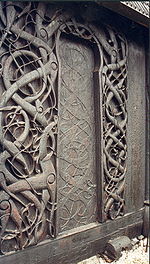
Runestone styles
Encyclopedia

- The term "runestone style" in the singular may refer to the Urnes styleUrnes styleThe Urnes style was the last phase of Scandinavian animal art during the second half of the 11th century and in the early 12th century. The preceding phases of Scandinavia's Viking Age animal ornamentation are usually categorized as Oseberg style, Borre style, Jelling style, Mammen style and...
.
The runestone styles varied during the Viking Age
Viking Age
Viking Age is the term for the period in European history, especially Northern European and Scandinavian history, spanning the late 8th to 11th centuries. Scandinavian Vikings explored Europe by its oceans and rivers through trade and warfare. The Vikings also reached Iceland, Greenland,...
. The early runestones were simple in design, but towards the end of the runestone era they became increasingly complex and made by travelling runemaster
Runemaster
A runemaster or runecarver is a specialist in making runestones.Most early medieval Scandinavians were probably literate in runes, and most people probably carved messages on pieces of bone and wood. However, it was difficult to make runestones, and in order to master it one also needed to be a...
s such as Öpir
Öpir
Öpir or Öper was a runemaster who flourished during the late 11th century and early 12th century in Uppland, Sweden...
and Visäte
Visäte
Visäte was a runemaster who was active during the last half of the eleventh century in southern Uppland, Sweden.-Work:...
.
A categorization of the styles was developed by Anne-Sophie Gräslund in the 1990s. Her systematization is considered to have been a break-through and is today a standard. The styles are RAK, Fp, Pr1, Pr2, Pr3, Pr4 and Pr5, and they cover the period 980-1130, which was the period during which most runestones were made.
The styles Pr1 and Pr2 correspond to the Ringerike style
Ringerike style
The Ringerike style is a Scandinavian animal style from the late 10th century and the 11th century, which evolved out of the earlier Mammen style. It has received its name from a group of runestones with animal and plant motifs in the Ringerike district north of Oslo. The most common motifs are...
, whereas Pr3, Pr4 and Pr5 belong to what is more widely known as the Urnes style
Urnes style
The Urnes style was the last phase of Scandinavian animal art during the second half of the 11th century and in the early 12th century. The preceding phases of Scandinavia's Viking Age animal ornamentation are usually categorized as Oseberg style, Borre style, Jelling style, Mammen style and...
.
Below follows a brief presentation of the various styles by showing sample runestones according to Rundata
Rundata
The Scandinavian Runic-text Data Base is a project involving the creation and maintenance of a database of runic inscriptions. The project's goal is to comprehensively catalog runestones in a machine-readable way for future research...
's annotation.
RAK
RAK is the oldest style and covers the period 980-1015 AD, but the Rundata project also includes the older runestones in this group, as well as younger ones. This style has no dragon heads and the ends of the runic bands are straight.Fp
This style is from the period c. 1010/1015 to c. 1040/1050, when Pr3 appeared. It is characterized by runic bands that end with animal heads seen from above.Pr (profile styles)
In the styles called Pr1, Pr2, Pr3, Pr4 and Pr5, the runic bands end with animal heads seen in profile.Pr1 (Ringerike style)
This style is contemporary with FP dated to c. 1010- c. 1050 when it was succeeded by Pr3.Pr2 (Ringerike style)
This style is only somewhat younger than the previous style and it is dated to c. 1020- c. 1050, and it was also succeeded by Pr3.Pr5 (Urnes style)
This style was the last one before runestones stopped being raised. It appeared c. 1080/1100 and lasted until c. 1130.KB
This style is used by the RundataRundata
The Scandinavian Runic-text Data Base is a project involving the creation and maintenance of a database of runic inscriptions. The project's goal is to comprehensively catalog runestones in a machine-readable way for future research...
project, although it does not attribute it to Gräslund's model. The style is common in western Södermanland and it is characterized by bordered crosses.
Sources and external links
- RundataRundataThe Scandinavian Runic-text Data Base is a project involving the creation and maintenance of a database of runic inscriptions. The project's goal is to comprehensively catalog runestones in a machine-readable way for future research...
- Edberg, Rune. Runriket Täby-Vallentuna – en Handledning
- Fuglesang, Signe Horn (1998). Swedish Runestones of the Eleventh Century: Ornament and Dating, Runeninschriften als Quellen Interdisziplinärer Forschung (K. Düwel ed.). Göttingen. pp. 197–218
- Sawyer, PeterPeter SawyerPeter Sawyer was an American thief and robber in New York City during the 1860s. A native of California, Sawyer appeared in New York's Forth Ward and the waterfront in the years following the American Civil War. He is credited as being the first criminal to drug victims for the purposes of mugging...
. (1997). The Oxford Illustrated History of the Vikings. Oxford: Oxford University Press. ISBN 9780192854346

